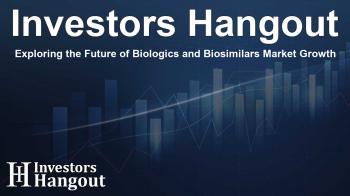Exploring the Future of Biologics and Biosimilars Market Growth

Overview of the Biologics and Biosimilars Market
The Biologics and Biosimilars market is experiencing substantial growth as demand rises. Research indicates that this market was valued at approximately USD 478.83 Billion, with expectations to reach USD 1,320.19 Billion by 2034. The anticipated compound annual growth rate (CAGR) during the forecast period from 2025 to 2034 is about 10.42%. New technologies in biomanufacturing and the expiration of patents on blockbuster biologics have opened doors for more affordable biosimilars, providing effective treatments for chronic diseases like cancer and diabetes. This trend suggests a positive outlook for industry stakeholders.
Market Drivers
Impact of Patent Expirations
One of the significant factors influencing market growth is the expiration of patents on several essential biologics. With these patents expiring, a wave of biosimilars is entering the market as cost-effective alternatives to high-priced original biologics. Pharmaceutical companies are now turning their focus on developing biosimilar pipelines to capture these emerging opportunities.
Increasing Burden of Chronic Diseases
The rising global prevalence of chronic diseases is another crucial driver of the biologics market. A growing aging population coupled with shifts in lifestyle factors has led to surging incidents of conditions such as diabetes, cancer, and autoimmune diseases. Biologics have become integral in managing these complex conditions effectively. Effective treatment protocols backed by biosimilars can help manage costs while ensuring quality healthcare delivery.
Regulatory Landscape
Streamlined Approvals Recognized Globally
The regulatory frameworks governing the market have also become more accommodating. Agencies such as the FDA and EMA have implemented biosimilars-specific guidance, creating a streamlined path for product development and approval. These advancements have reduced barriers to entry and fostered competition, encouraging pharmaceutical companies to invest in biosimilar portfolios.
Regional Adoption Patterns
The acceptance of biosimilars varies widely across regions. Europe has emerged as a leader in biosimilar adoption, propelled by supportive regulations and early physician acceptance. Conversely, the U.S. has shown a slower uptake due to regulatory hurdles, yet there is a notable shift towards greater acceptance with growing evidence supporting the efficacy of biosimilar products.
Challenges and Opportunities
Market Competition
The competition in the biologics and biosimilars market is intensifying. While established pharmaceutical giants continue to innovate and develop new therapies, biosimilar manufacturers face challenges in navigating complex payer structures and varying reimbursement policies. However, the expiration of patents offers a fertile ground for biosimilar developers to thrive.
Patient and Prescriber Confidence
For the biosimilars market to grow, trust among patients and healthcare providers is crucial. Initial reservations regarding the efficacy and safety of biosimilars have started diminishing, supported by real-world evidence and educational initiatives. Physician advocacy programs are imperative to build familiarity and confidence in switching, especially in chronic treatment areas.
Market Segmentation
By Product Type
The biologics and biosimilars market can be segmented by product types such as monoclonal antibodies, insulin, and recombinant hormones, among others. Each category caters to different therapeutic applications including treatment for various diseases like autoimmune disorders and oncology.
By Therapeutic Application
The therapeutic applications of biologics and biosimilars target critical areas, reflecting the diverse scope of treatment modalities. Increased innovation is leading to the development of biologics for rarely treated conditions, further enhancing market growth opportunities.
Conclusion
The future of the Biologics and Biosimilars market is bright, with anticipated growth driven by several interrelated factors such as aging populations, rising chronic diseases, and the introduction of biosimilar alternatives. With advancements in regulatory frameworks and increasing acceptance among healthcare providers and patients, the groundwork is laid for a thriving market that benefits all stakeholders.
Frequently Asked Questions
1. What is the current value of the Biologics and Biosimilars market?
The market was valued at approximately USD 478.83 Billion and is expected to reach about USD 1,320.19 Billion by 2034.
2. What is contributing to the growth of this market?
Key factors include the expiry of crucial biologic patents, rising demand due to chronic diseases, and advancements in production technology.
3. How does the regulatory environment affect the market?
Regulatory frameworks have become more favorable, enhancing the path for product approvals, which in turn fosters competition.
4. What regions are leading in biosimilar adoption?
Europe leads the way in biosimilar adoption, while the U.S. is gradually increasing its acceptance.
5. What challenges do biosimilar manufacturers face?
Biosimilar manufacturers encounter challenges such as market competition, fluctuating payer reimbursement policies and the need for building trust among healthcare providers.
About The Author
Contact Ryan Hughes privately here. Or send an email with ATTN: Ryan Hughes as the subject to contact@investorshangout.com.
About Investors Hangout
Investors Hangout is a leading online stock forum for financial discussion and learning, offering a wide range of free tools and resources. It draws in traders of all levels, who exchange market knowledge, investigate trading tactics, and keep an eye on industry developments in real time. Featuring financial articles, stock message boards, quotes, charts, company profiles, and live news updates. Through cooperative learning and a wealth of informational resources, it helps users from novices creating their first portfolios to experts honing their techniques. Join Investors Hangout today: https://investorshangout.com/
The content of this article is based on factual, publicly available information and does not represent legal, financial, or investment advice. Investors Hangout does not offer financial advice, and the author is not a licensed financial advisor. Consult a qualified advisor before making any financial or investment decisions based on this article. This article should not be considered advice to purchase, sell, or hold any securities or other investments. If any of the material provided here is inaccurate, please contact us for corrections.

